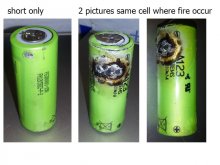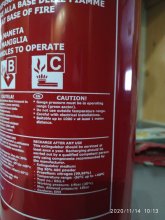I also use to think lifepo4 didnt catch on fire, but now I know better. They are safe as far as they can "probably" handle being overcharged unlike lipo/li-ion but you never want to short one out. A while back I was taking a battery pack apart that had the A123 26650 lifepo4 cells (2300mah) , I accidentally shorted one of the cells, which punctured a hole in the side of the cell. I hear pressure escaping and then the cell catches on fire, the fire was very violent like a blowtorch.
I had a small bottle of water, and pour that on the cell to keep the fire from spreading to the other cells. The water also kept the other cells cool. The water would knock the fire down but it reignited as soon as you took the water away. After about a minute the pressure was spent and fire went out. As far as fumes etc, I didnt notice or smell anything abnormal.
It was a worst case scenario but you always have to plan for everything. Now I treat all lifepo4 as being as dangerous as li-ion. I built many li-ion packs and never had any fires from the 18650. I still use the A123 in some jump packs, they are very good cells.
I know from my experience if its 1 or 2 cells and you can keep the fire from spreading, water will work, but you need to keep pouring it on the fire until it stops reflashing.

I had a small bottle of water, and pour that on the cell to keep the fire from spreading to the other cells. The water also kept the other cells cool. The water would knock the fire down but it reignited as soon as you took the water away. After about a minute the pressure was spent and fire went out. As far as fumes etc, I didnt notice or smell anything abnormal.
It was a worst case scenario but you always have to plan for everything. Now I treat all lifepo4 as being as dangerous as li-ion. I built many li-ion packs and never had any fires from the 18650. I still use the A123 in some jump packs, they are very good cells.
I know from my experience if its 1 or 2 cells and you can keep the fire from spreading, water will work, but you need to keep pouring it on the fire until it stops reflashing.







